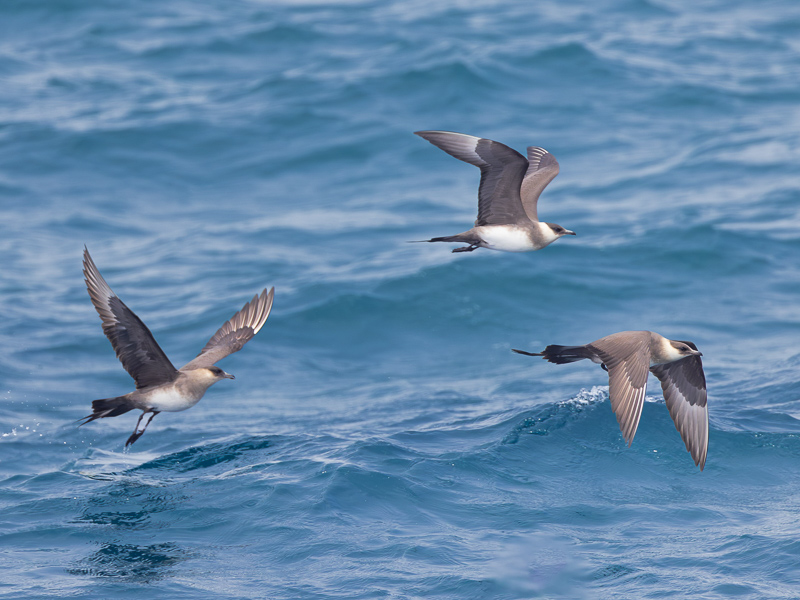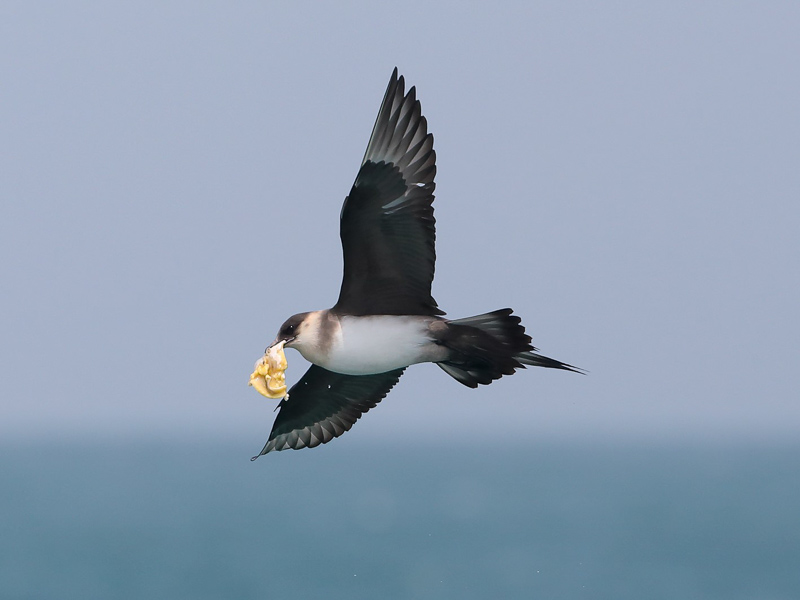Parasitic Jaeger Stercorarius parasiticus 短尾賊鷗
Category I. Scarce passage migrant through offshore waters in spring.
IDENTIFICATION

May 2023, Zhou Zhe.
37-44 cm (excluding tail streamers). Fast falcon-like flight, relatively small head and finer bill compared to Pomarine Skua.
Compared to Pomarine, adult has paler and less extensive dark cap that does not extend below gape, small pale spot above bill base, less well-marked breast band and lacks heavy spotting on flanks.

May 2018, Michelle and Peter Wong. Adult.
Two central tail feathers are long, thin and pointed, and project up to several centimetres beyond tail tip.
For detail on immature plumages see Olsen and Larsson (1997).
VOCALISATIONS
No reports of vocalising in HK. The typical short call is a ‘kyeeow’ or ‘kyeeor’.
DISTRIBUTION & HABITAT PREFERENCE
All records have occurred offshore, largely from boat-based surveys in southern waters.
OCCURRENCE
First recorded on 1st and 2 May 1999 during the close approach of a tropical storm (Turnbull 2004), Parasitic Jaeger has occurred annually since 2005 largely due to boat-based observations in southern waters during the period of passage. The earliest record occurred on 21 March 2020, while the latest occurred on 19 June 2009. As Figure 1 indicates, most birds are recorded in April and the first half of May.
The highest count remains the 16 recorded from Cape D’Aguilar during a tropical storm on 2 May (two were recorded the previous day), followed by ten off Po Toi on 1 April 2012. Most records, however, are of up to six birds in a day, mostly adults.
BEHAVIOUR, FORAGING & DIET
One was seen harrying a Black-legged Kittiwake, but no other observations.
RANGE & SYSTEMATICS
Monotypic. Circumpolar breeding distribution in Arctic tundra; winters near coasts in southern hemisphere (Wiley and Lee 2020). In China a passage migrant through sea areas (Liu and Chen 2020).
CONSERVATION STATUS
IUCN: Least Concern. Population trend stable.
Figure 1.

Liu, Y. and Chen, Y.H. (eds) (2020). The CNG Field Guide to the Birds of China (in Chinese). Hunan Science and Technology Publication House, Changsha.
Olsen, K. M. and H. Larsson (1997). Skuas and Jaegers. A Guide to the Skuas and Jaegers of the World. Pica Press, Sussex.
Turnbull, M. (2004). Parasitic Jaegers past Cape D’Aguilar during Typhoon Leo: the first record for Hong Kong. Hong Kong Bird Report 1999: 185-188.
Wiley, R. H. and Lee, D. S. (2020). Parasitic Jaeger (Stercorarius parasiticus), version 1.0. In Birds of the World (S. M. Billerman, Editor). Cornell Lab of Ornithology, Ithaca, NY, USA. https://doi.org/10.2173/bow.parjae.01

